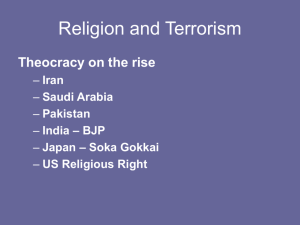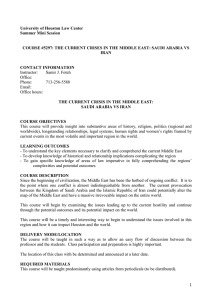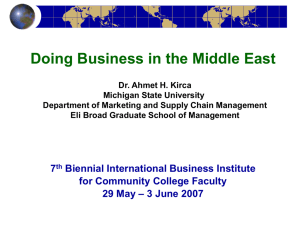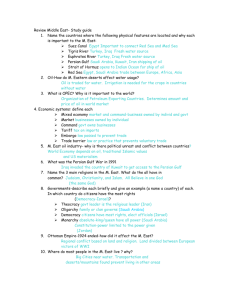6 The RAND Corporation is a nonprofit from
advertisement
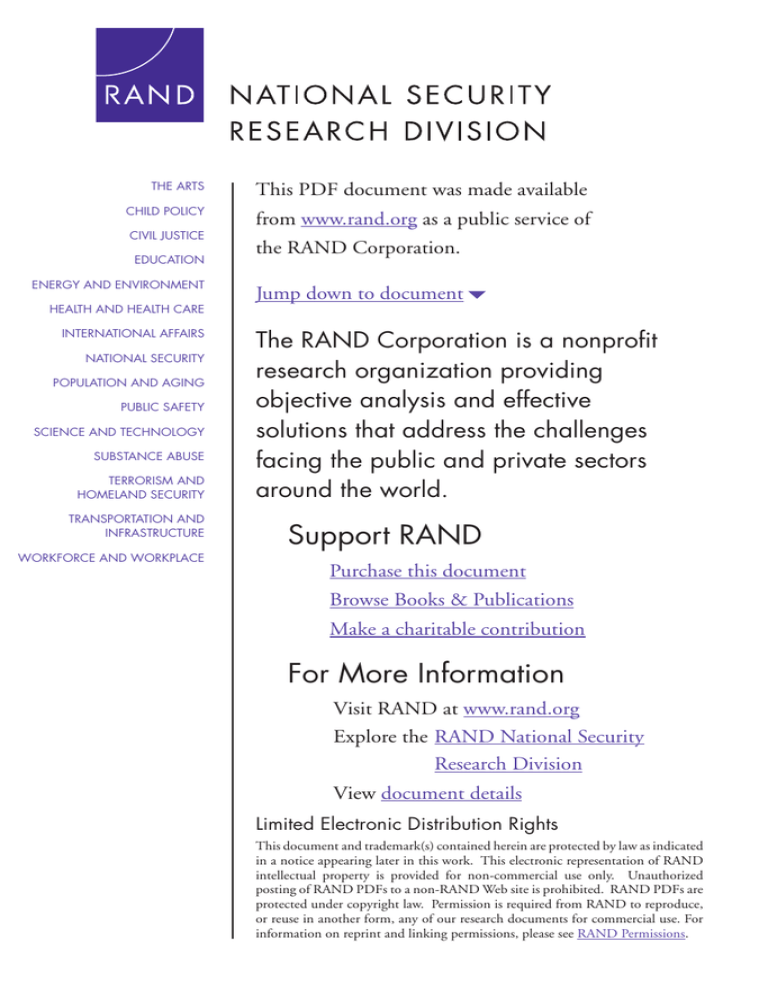
THE ARTS This PDF document was made available CHILD POLICY from www.rand.org as a public service of CIVIL JUSTICE EDUCATION ENERGY AND ENVIRONMENT HEALTH AND HEALTH CARE INTERNATIONAL AFFAIRS NATIONAL SECURITY POPULATION AND AGING PUBLIC SAFETY SCIENCE AND TECHNOLOGY SUBSTANCE ABUSE TERRORISM AND HOMELAND SECURITY TRANSPORTATION AND INFRASTRUCTURE WORKFORCE AND WORKPLACE the RAND Corporation. Jump down to document6 The RAND Corporation is a nonprofit research organization providing objective analysis and effective solutions that address the challenges facing the public and private sectors around the world. Support RAND Purchase this document Browse Books & Publications Make a charitable contribution For More Information Visit RAND at www.rand.org Explore theRAND National Security Research Division View document details Limited Electronic Distribution Rights This document and trademark(s) contained herein are protected by law as indicated in a notice appearing later in this work. This electronic representation of RAND intellectual property is provided for non-commercial use only. Unauthorized posting of RAND PDFs to a non-RAND Web site is prohibited. RAND PDFs are protected under copyright law. Permission is required from RAND to reproduce, or reuse in another form, any of our research documents for commercial use. For information on reprint and linking permissions, please see RAND Permissions. This product is part of the RAND Corporation monograph series. RAND monographs present major research findings that address the challenges facing the public and private sectors. All RAND monographs undergo rigorous peer review to ensure high standards for research quality and objectivity. Saudi-Iranian Relations Since the Fall of Saddam Rivalry, Cooperation, and Implications for U.S. Policy Frederic Wehrey, Theodore W. Karasik, Alireza Nader, Jeremy Ghez, Lydia Hansell, Robert A. Guffey Sponsored by the Smith Richardson Foundation NATIONAL SECURITY RESEARCH DIVISION The research described in this report was sponsored by the Smith Richardson Foundation and was conducted under the auspices of the International Security and Defense Policy Center within the RAND National Security Research Division (NSRD). NSRD conducts research and analysis for the Office of the Secretary of Defense, the Joint Staff, the Unified Commands, the defense agencies, the Department of the Navy, the Marine Corps, the U.S. Coast Guard, the U.S. Intelligence Community, allied foreign governments, and foundations. Library of Congress Cataloging-in-Publication Data Saudi-Iranian relations since the fall of Saddam : rivalry, cooperation, and implications for U.S. policy / Frederic Wehrey ... [et al.]. p. cm. Includes bibliographical references. ISBN 978-0-8330-4657-4 (pbk. : alk. paper) 1. Saudi Arabia—Foreign relations—Iran. 2. Iran—Foreign relations—Saudi Arabia. 3. United States—Foreign relations—Persian Gulf States. 4. Persian Gulf States—Foreign relations—United States. I. Wehrey, Frederic M. DS228.I7S28 2009 327.538055—dc22 2009008205 Cover photo courtesy of Getty Images. Photographed by Hassan Ammar. The RAND Corporation is a nonprofit research organization providing objective analysis and effective solutions that address the challenges facing the public and private sectors around the world. RAND’s publications do not necessarily reflect the opinions of its research clients and sponsors. R® is a registered trademark. © Copyright 2009 RAND Corporation Permission is given to duplicate this document for personal use only, as long as it is unaltered and complete. Copies may not be duplicated for commercial purposes. Unauthorized posting of RAND documents to a non-RAND Web site is prohibited. RAND documents are protected under copyright law. For information on reprint and linking permissions, please visit the RAND permissions page (http://www.rand.org/publications/permissions.html). Published 2009 by the RAND Corporation 1776 Main Street, P.O. Box 2138, Santa Monica, CA 90407-2138 1200 South Hayes Street, Arlington, VA 22202-5050 4570 Fifth Avenue, Suite 600, Pittsburgh, PA 15213-2665 RAND URL: http://www.rand.org To order RAND documents or to obtain additional information, contact Distribution Services: Telephone: (310) 451-7002; Fax: (412) 802-4981; Email: order@rand.org Summary The fall of Iraqi President Saddam Hussein in 2003 and the war in Iraq have affected sweeping changes in the strategic landscape of the Middle East, radically shifting the regional balance of power. Old security paradigms have been thrown into question, and local states appear to be reaffirming, renegotiating, or rethinking their relations with one another and with outside powers. Saudi Arabia and Iran have in many respects been the central players in this unfolding transformation. The dynamic relations between the two powers have affected the Persian Gulf, Iraq, Lebanon, and Palestine with important implications for regional stability and U.S. interests. Bilateral Tensions Affect Regional Stability and U.S. Interests Saudi Arabia and Iran are divided by long-standing structural tensions. Each has aspirations for Islamic leadership, and each possesses different visions of regional order. Whereas Tehran regards Riyadh as America’s proxy and a buffer against Iran’s rightful primacy in the Gulf, Saudi Arabia worries about Iran’s asymmetric power and regional ambitions, especially its expanding influence in post-Saddam Iraq and its alleged pursuit of a nuclear weapon. A particular concern in Riyadh is Iran’s ability to challenge the legitimacy of the al-Saud before regional and domestic audiences by upstaging them on pan-Arab issues such as Palestine. ix x Saudi-Iranian Relations Since the Fall of Saddam The countries are further divided by political ideologies and governance. The philosophy of the Islamic Republic explicitly rejects the kinds of monarchical regimes seen in Saudi Arabia and other Arab states, legitimates the authority of the Iranian clerical elite, and incorporates quasi-democratic institutions. For their part, the rule of the al-Saud rests on their claim to custodianship of the Islamic holy sites in Mecca and Medina, dynastic privilege, a symbiotic but ultimately dominant relationship with the Saudi clerical class, and a celebration of the state-building achievements of Ibn Saud. Energy differences are a third source of tension. Whereas Saudi Arabia can afford to take a long-term view of the global oil market and has incentives to moderate prices, Iran is compelled by its smaller oil reserves and larger population to focus on high prices in the short term. Together, these factors—along with the well-known sectarian and ethnic fissures that divide the Saudi and Iranian populations— would seem to predispose the two countries toward chronic hostility. Regional and Western commentators have warned of a Saudi-Iranian “proxy” conflict engulfing the region or a return to the ideological “Cold War” that marked the bilateral relationship after the 1979 Iranian Revolution. Attempting to capitalize on the sources of enmity between the two states, the United States has thus far adopted a policy that tacitly endorses Saudi Arabia as an “Arab balancer” against Iran. This approach is based on the idea that the Sunni-Shi’a divide and other structural tensions naturally place Arab Gulf countries on one side of the equation and Iran on the other. The hope is that a bloc of “moderate Arab states,” led by Saudi Arabia and sponsored by the United States, can check Iranian influence in the region. Conventional Thinking About Saudi-Iranian Relations Must Be Reexamined Yet the relationship between Saudi Arabia and Iran is more complex, dynamic, and multidimensional than the “bloc” approach seems to allow. This report documents a study by the RAND National Security Summary xi Research Division of how the bilateral relationship has shaped and been shaped by the political and ideological changes that have taken place since the fall of Saddam Hussein in 2003. The study concludes that conventional thinking about Saudi-Iranian relations must be reexamined. Four findings in particular challenge traditional assumptions: The Sunni-Shi’a Divide Has Strained the Relationship, but It Is Not the Key Driver Sectarian and ideological differences between the two states have had an “echo effect” on the region, but they are not the principal determinants in the policy outlook of each regime. The Sunni-Shi’a divide certainly factors into the calculus of the leadership and is either encouraged or downplayed as a tool in larger game of geopolitical maneuvering. Moreover, the leadership in each country must also contend with key constituents for whom sectarianism is deeply embraced, although this is more the case in Saudi Arabia than in Iran. The Saudi regime faces pressure from Salafi clerics to take an antiShi’a position in its dealings with Iran, and in late 2006 there was indeed mounting Saudi public pressure to protect Sunnis in Iraq. At the same time, the ruling elite in Saudi Arabia appear to have exploited or tacitly endorsed this rhetoric as a way to counter the greater threat of Iran’s pan-Islamist populism. Put differently, faced with a contender for symbolic leadership in the Middle East, Saudi Arabia has tried to paint Iran as a cultural and ideological aberration from the rest of the region, and the most expeditious means of doing this has been to cast the Islamic Republic’s Shi’a/Persian ambitions as a threat to Sunnis everywhere. One unintended victim of this tactic has been Saudi Arabia’s own Shi’a community. For its part, Iran has tended to downplay sectarianism in the bilateral relationship, criticizing anti-Shi’a rhetoric from the Kingdom but often displaying recognition of the distinction between Saudi clerical voices and the Saudi regime. Moreover, the two states have at times taken steps to mitigate sectarian conflict in Lebanon and Iraq in order to pave the way for coordination on a range of economic and political issues. xii Saudi-Iranian Relations Since the Fall of Saddam The More Fundamental Disagreement Is over Regional Hierarchy and the Role of the United States Since 2003, the fundamental driver of the relationship is a struggle to shape the regional balance of power. Each state sees the expansion of regional influence by the other as a net loss for itself, whether in Palestine, Lebanon, Iraq, or the Gulf littoral. This game of geopolitics is aided by the fact that the regional landscape is defined by weak states and contending local factions that invite outside meddling. In many cases, these factions line up along the Shi’a-Sunni divide, and thus Saudi and Iranian patronage invariably exacerbates a dangerous form of sectarian politics, whether or not this is the original intent of policymakers in Riyadh and Tehran. In maneuvering on this landscape, Saudi Arabia and Iran wield asymmetrical policy tools; neither is likely to confront the other on the conventional battlefield. Iran is more adept at backing militant nonstate actors and playing a rejectionist trump card on issues such as Palestine and the U.S. presence in the region—a tactic that has formed an indirect critique of U.S.-allied regimes and in particular Gulf states that have adopted increasingly accommodating stances toward Israel. For its part, Saudi Arabia brings to bear greater financial resources, control of pan-Arab media outlets, and the backing of the region’s key external power. However, as we argue in this report, these attributes do not translate into greater regional legitimacy for the al-Saud or unwavering Arab consensus for Saudi leadership against Iran. Rather, quite the opposite may be true. Riyadh has therefore been careful to balance alignment with U.S. initiatives with its own unilateral diplomacy—both for symbolic reasons and because it has increasingly perceived U.S. policy toward Iran to be in disarray. Containment of Iran by Saudi Arabia and the Gulf States Is Unrealistic The notion of a watertight bloc of Gulf Arab states opposing Iran is therefore unrealistic, given the ambiguity about Saudi leadership, but also disunity within the Gulf Cooperation Council (GCC) and in particular the tendency of Qatar and Oman to go it alone. The tradition of Summary xiii bilateral dialogue between the individual Gulf states and Iran implicitly favors Tehran and has complicated Riyadh’s efforts at confronting Iran. Moreover, Saudi Arabia has shown the tendency to accommodate and engage Iran in the Gulf when it perceives ambiguity and confusion in U.S. policy; the Saudi overture to Iran in the wake of the 2007 U.S. National Intelligence Estimate (NIE),1 which was viewed in Riyadh as a downgrading of the Iranian threat, is a good example of this dynamic at work. For its part, Tehran’s posture toward Saudi Arabia and the Gulf has been affected by an internal debate between factions who see the Gulf as a zone of economic enrichment and multilateral diplomatic cooperation, and those who take a more hegemonic, proprietary view, preferring the instruments of intimidation and threat. It should be emphasized, however, that both sides in Tehran are united in the view that the U.S. presence as an external security guarantor should end—a view that is unacceptable to Saudi Arabia. Iran Has Little Influence over Shi’as in Saudi Arabia and the Gulf, but Shi’a Marginalization Is a Continuing Concern Despite these signs of accommodation in the Gulf, it is worth noting that the political marginalization and economic deprivation of Shi’a communities in Saudi Arabia’s Eastern Province, Bahrain, and, to a lesser extent, Kuwait are potential flashpoints in the future. The Gulf Shi’as can hardly be considered “proxies” of Tehran; most regard the Islamic Republic with a degree of spiritual and emotional affinity but not as an object of political emulation. Yet more hard-line and radical elements may become empowered, particularly among the younger generation, if these communities continue to perceive a lack of progress on political inclusion, civil rights, and economic improvement. 1 Office of the Director National Intelligence and the National Intelligence Council, Iran: Nuclear Intentions and Capabilities, November 2007. xiv Saudi-Iranian Relations Since the Fall of Saddam Saudi Arabia and Iran Compete, Coordinate, and Engage in Different Arenas of the Middle East The relationship between Saudi Arabia and Iran as it is evolving today appears to incorporate elements of both sectarian confrontation and pragmatic rapprochement. As in earlier periods (e.g., before the Iranian Revolution in 1979 and during the warming of relations in the mid1990s), the two countries are showing their ability to reach an accommodation on regional order while minimizing deeper ideological and structural tensions. This hybrid approach plays out in different ways throughout the regions where the two countries come into contact—in Iraq, the Gulf, and the Levant. Riyadh and Tehran Perceive Iraq as a Zero-Sum Game Much focus has been directed at Iraq as an arena for “proxy” competition between Saudi Arabia and Iran, particularly in the event of a U.S. withdrawal. Saudi Arabia’s previous warnings that it will increase its involvement in Iraq following a U.S. departure should not be dismissed. But its ability to support and influence Sunni factions should not be inflated, and its role in containing Iranian influence in Iraq may be more limited than is realized. A key theme is Saudi Arabia’s desire to keep the United States involved in Iraq as a balancer and, absent this, to play a role in shaping the outcome of any trilateral Iranian-U.S.-Iraqi talks. Sensing that this strategy may be eroding, Riyadh has recently taken steps to diversify and strengthen its contacts with a range of Iraqi political actors. Meanwhile, Iran has made overtures to Saudi Arabia about a sort of cooperative power-sharing relationship over Iraq that may mirror past coordination on Lebanon but that explicitly calls for the departure of U.S. forces. Riyadh likely sees this overture for what it is: an attempt to deprive Saudi Arabia of its external patron and relegate it to the status of junior partner in the new regional order. Instead of true cooperation, the Saudi-Iranian relationship over Iraq is likely to be defined as “managed rivalry,” with a modicum of coordination and contact to prevent an escalation of sectarian conflict, which would benefit neither side. Summary xv Riyadh and Tehran Have Tried to Regulate Tensions over Iran’s Nuclear Program The advent of a nuclear-armed Iran would likely be perceived as an existential threat to Riyadh, possibly pushing Saudi Arabia to acquire its own countervailing deterrent. The Saudi reaction will likely be a key pivot around which the rest of the region’s reactions will turn; interviews conducted by RAND researchers suggest widespread unease, particularly among smaller Gulf states, about Saudi Arabia’s potential “overreaction” to the advent of a nuclear Iran. Current relations over the nuclear issue, however, are more muted than might be expected. In its approach, Riyadh appears to adhere more closely to the European line of treating the Iranian issue within the context of a WMDfree Middle East, which would include Israel. Such pronouncements are partly calculated to imply Riyadh’s non-support for a U.S. strike, which Saudi Arabia perceives might engender domestic public opposition and erode the Kingdom’s legitimacy on the Arab stage. Iran, for its part, appears to see the nuclear impasse as manageable. Through its official and unofficial press outlets, Iran has portrayed mutual harmony with Saudi Arabia on the issue, often citing what it perceives to be Riyadh’s acceptance of the program’s peaceful nature. Rivalry in the Levant Is More Explicit If Saudi-Iranian relations in the Gulf and Iraq are based on engagement and containment, respectively, then the Levant is best characterized as an arena for more open competition and rivalry. Much of this stems from Saudi perception of the Iranian threat. In the normative realm of Saudi public perception and belief in the legitimacy of the monarchy, Iran’s actions in the Arab-Israeli sphere do far more harm to the al-Saud than its actions in Iraq. It was Hizballah’s 2006 war with Israel that opened significant rifts inside Saudi policy circles and among the clerical elite and put the al-Saud in the awkward position of being upstaged on the Israeli-Palestinian issue by a non-Arab, Shi’a power. Riyadh also likely perceives that to keep its influence in the pan-Arab realm it must take a more proactive stance on the IsraeliPalestinian issue, as well as Lebanon. xvi Saudi-Iranian Relations Since the Fall of Saddam Riyadh is currently focused on trying to isolate and weaken Syria since the assassination of Lebanese Prime Minister Rafik Hariri, while tacitly supporting the Turkish-Israeli effort to pry Damascus from Iran’s orbit and lure it back to the Arab fold. In response, Iran has attempted to paint Saudi policies as explicitly sectarian in nature in order to discredit its role as a broker, either on the Israeli-Palestinian issue or in Lebanon. The Iranian press has highlighted Riyadh’s support to radical Salafi groups and has gone so far as to implicate it in the assassination of Hizballah commander Imad Mughniyah. An important dimension of the relationship in the Levant is the way it conditions the views of local actors, particularly in Lebanon; outside meddling and interference has been used by competing Lebanese factions as justification for avoiding compromise. Implications for U.S. Policy Incorporating the themes outlined above, U.S. policy can better manage the implications of the Saudi-Iranian relationship in the following ways: View Saudi Arabia Less as a Bulwark Against Iran and More as an Interlocutor U.S.-Saudi interests are aligned against Iran in many ways, but Riyadh is unlikely to act in lockstep with Washington’s strategy. Indeed, the current Saudi-centric containment strategy appears to have been overtaken by events, with the Kingdom pursuing a nuanced approach that incorporates elements of accommodation, engagement, and rollback. A U.S. paradigm that views Saudi Arabia as a confrontational proxy against Iran, with the expectation that Riyadh will employ all levers of influence at its disposal, does not reflect regional reality or the pattern of interaction between the two states. Riyadh has a demonstrated tendency to hedge its bets, to avoid taking stark policy decisions, and to keep multiple options open—especially in the context of what it perceives as inconsistent and ambiguous U.S. policies toward Iran. Summary xvii In this light, recommendations that Riyadh confront China and Europe to sever their business ties with Iran or risk losing economic access to the Kingdom are probably not viable options for exerting multilateral pressure on Iran’s nuclear ambitions. Moreover, regional observers see little role for Saudi Arabia as a real balancer against Iran, but rather view it as a critical pillar in a diplomatic vanguard that includes Egypt and Jordan. Some voices in Saudi Arabia appear to appreciate the Kingdom’s role as an interlocutor between Iran and the United States, although the leadership in Riyadh remains fundamentally fearful of an eventual U.S.-Iranian reconciliation. The United States should seek to cultivate Saudi moves toward dialogue, encouraging Saudi outreach to Tehran while at the same time working to resolve the arenas of competition between the two states, particularly on the Arab-Israeli front. Much of this depends on a unilateral de-escalation of U.S. rhetoric on Iran, combined with U.S. endorsement of a broader Gulf engagement with Tehran. If the Saudis perceive that the weight of regional and U.S. diplomacy is geared toward dialogue, they would have strong incentives to play a key role, lest smaller Arab states outbid them. However, a muddled U.S. approach to Iran along with frequently confrontational rhetoric plays into the hands of more hard-line factions in Riyadh who eschew engagement. Seek Saudi Burden-Sharing in Iraq, but Not to Counteract Iran As noted above, it is important that the United States not exaggerate Saudi Arabia’s influence over Sunni factions in Iraq or view it as analogous to Iran’s influence. The Saudis themselves appear to recognize this and are diversifying the breadth and intensity of their contacts with a wide range of Iraqi political factions. The United States should encourage this trend, but with the understanding that these levers should work toward the stabilization and equitable political development of Iraq, rather than the targeted rollback of Iranian influence. Already, Tehran is alarmed that the Sunni tribal strategy employed in al-Anbar against al-Qaeda could be replicated among southern Shi’a tribes against Iranian influence, and it likely views Saudi Arabia as a potential patron in this effort, despite the sectarian divide. Taken together with Tehran’s xviii Saudi-Iranian Relations Since the Fall of Saddam long-standing perception of Riyadh’s incitement of Sunni volunteers to Iraq, this could significantly exacerbate tensions, with destabilizing consequences for Iraq and the broader region. It is ultimately the Iraqi government and public who will determine the type and scope of Iranian influence over Iraq’s political, economic, and social affairs. One of the important indigenous buffers to Iranian interference is Iraqi nationalism, which appears to be asserting itself in light of growing public intolerance for Iran’s lethal support to Shi’a militias in mid-2008, the ratification of the U.S.-Iraq Strategic Framework Agreement (SFA) in November 2008, and the defeat of the Iranian-backed Islamic Supreme Council of Iraq (ISCI) in the January 2009 provincial elections. Taking this into account, Washington should expend great effort to allay Saudi fears about Iran’s actual and future influence over Iraqi Shi’as. To do this, the United States must carefully set the stage for the drawdown of U.S. forces—providing necessary security guarantees to Riyadh yet also communicating to the Iraqi government the importance of building institutions in a nonsectarian manner, particularly the Iraqi Security Forces, and integrating the Sunni-based Awakening Councils and Sons of Iraq into Iraqi political life. In light of these confidencebuilding measures, Saudi Arabia must be encouraged to expand its diplomatic contacts with Iraq, as with any neighboring country. Most specifically, Saudi Arabia must be encouraged to open an embassy in Baghdad. This would signal to Iran the necessity of acknowledging the country’s links to the Sunni west, normalizing its relations with Iraq, and ending its policy of lethal aid to Shi’a militias. Encourage Saudi Initiatives on the Arab-Israeli Front This study argues that Iran’s threat to Saudi Arabia is not necessarily as a conventional military power but rather as a state that seeks to symbolically challenge the Kingdom’s claim to leadership on Arab issues, particularly on Palestine. Iran’s militant nonstate allies are players in this strategy, dependent on Syria as a key conduit. Much of the focus by Saudi Arabia is geared toward eliminating this conduit by wrestling Syria away from Tehran. Yet Riyadh is unlikely to find a compromise with Damascus on the Hariri issue, and, given the durability Summary xix and robustness of the Tehran-Damascus axis, energy might be better expended on other areas. Specifically, regional peace initiatives such as that put forward by Saudi King Abdullah are proactive efforts that help isolate Iranian rejectionism on the Arab-Israeli front, even if they ultimately fall short of achieving a lasting peace. Washington should be cognizant, however, of how intra-Arab rivalries, particularly within the GCC, can undermine Saudi initiatives on the Palestine issue and against Iran. Push for Domestic Reform in Saudi Arabia and the Gulf to Mitigate Sectarianism The sectarian dimension of Saudi-Iran relations partly stems from political inequity among the Gulf Shi’as and fears by Riyadh and other Sunni regimes that these populations are susceptible to Iranian influence. The mid-1990s have shown that genuine efforts toward integration and dialogue between rulers and their Shi’a populations has the effect of lessening Iran’s attractiveness as an external patron. Conversely, the hardening of anti-Shi’a discrimination and backtracking on reforms could make Shi’a public opinion swing more toward more radical domestic factions who are influenced by Iran or who seek to emulate the Hizballah model in the Gulf. More equitable power sharing, in which hard-line Salafi clerics are prevented from airing their anti-Shi’a views, will also improve Saudi-Iranian bilateral relations and reduce sectarian tensions. Ultimately, the United States and regional governments must acknowledge that the threat of an Iranian-backed Shi’a fifth column in the Gulf is overblown, but that stagnation on reform and rights toward the Shi’as could make these fears a self-fulfilling prophecy. Washington should avoid viewing sectarian tension as an inevitable feature of the bilateral relationship, but rather recognize such tension as a by-product of fundamental power inequities in the Gulf that can be improved through reform. At the same time, the United States should understand that the scope and pace of any reforms will be determined by the Gulf states themselves. xx Saudi-Iranian Relations Since the Fall of Saddam Avoid Actions That Inflame Iranian Perceptions of External Meddling in Its Affairs Iran has great reason to fear external meddling in its internal affairs, particularly given a long pattern of historical interference by Western powers, of which the most notorious is the 1953 coup against Prime Minister Mohammed Mossadegh.2 The fall of Saddam has only heightened this perception, and Tehran fears that a decentralized Iraq could increase dissent among the ethnic and sectarian groups within its own borders. The Sunnis in Baluchestan and the Arabs in Khuzestan are potential concerns, as is Iran’s perception of a Saudi role in agitating both populations. While much of this fear is undoubtedly exaggerated, Washington can mitigate it as a source of Saudi-Iranian tension by abandoning the idea that domestic dissent inside Iran can be engineered from the outside. If, on the other hand, this idea grows, the potential for what one Saudi interlocutor called a “dirty war” escalating among proxy groups outside the territories of each country could grow, to the detriment of U.S. interests and regional stability. Pursue Saudi-Iranian Endorsement of Multilateral Security for the Gulf This study found that the Gulf is one arena where bilateral tensions have been regulated by a host of shared interests. Capitalizing on this dynamic, the United States should work toward a more cooperative Gulf security arrangement that recognizes Iran as a valid player but assuages Saudi and Gulf concerns about Iranian dominance. A conflict-regulating “concert” system, like the Organization for Security and Cooperation in Europe (OSCE), bears further consideration in this regard. In this sort of forum, mutual threat perceptions are aired and conflict-reduction measures are pursued. Cooperation in the maritime area would be a useful area of focus for such a forum (such as work on a regional incidents-at-sea agreement), particularly given the potential for miscalculation and escalation in critical waterways, such as the Strait of Hormuz. This proposed structure is not without its drawbacks: The Saudi preference for an external, nonregional security guarantor has been 2 The coup was orchestrated by the CIA and Britain’s Secret Intelligence Service (SIS). Summary xxi noted, and Iran is suspicious that such proposals are merely a cover for increased U.S. hegemony. Smaller Gulf states, such as Oman and Qatar, are unlikely to join until the future of Iraq is secured, and many will continue their preference for bilateral ties with the United States, fearful of Saudi Arabia’s dominance. In addition, the GCC’s internal political tensions, such as Shi’a marginalization, make the implementation of this structure more problematic; as we have seen, much of the Gulf states’ threat perception of Iran is a mirror of domestic regime insecurity. Thus, internal reform and liberalization remain key priorities. Despite these obstacles, a new paradigm that does not focus on a specific threat, but rather provides an open-ended security forum in which regional states can discuss and address a range of challenges, stands a better chance than a more traditional balancing approach that imparts too much confidence in Riyadh’s will and capabilities to act as a true counterweight to Iran.

